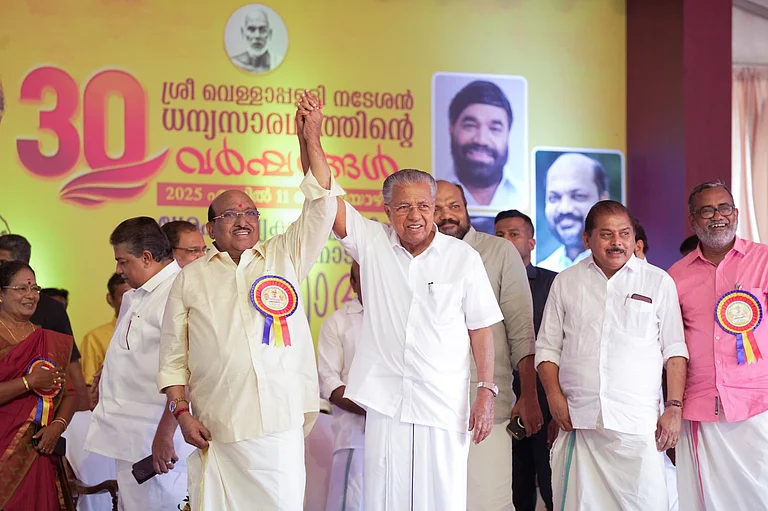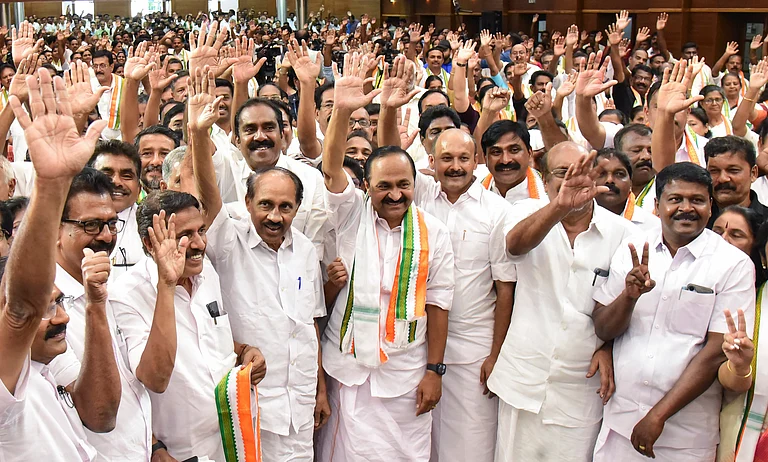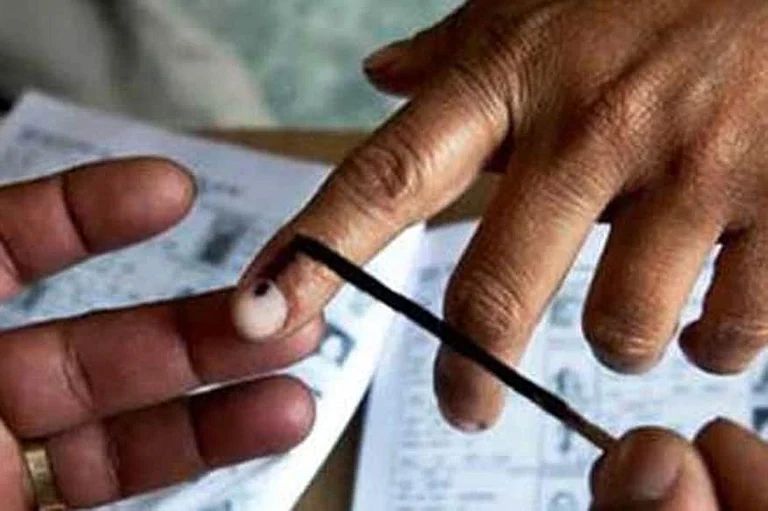On the evening of March 12, the Left Democratic Front (LDF) organised a massive night march in Thalassery, Kannur, protesting the notification of the Citizenship Amendment Act (CAA).
Hundreds of people flooded the streets, their torches blazing with determination. Hijab-clad women, a rare sight, especially at a night rally, joined the protest in north Kerala, underscoring widespread opposition to the CAA. The vibrant scene, with chants and banners, painted a vivid picture of resistance, echoing demands for justice and equality.
In the rally’s front row, was KK Shailaja, Kerala’s former Health Minister, a sitting MLA, who is contesting for the Vadakara Lok Sabha constituency. She was widely acclaimed as the 'Corona Slayer - the Rock Star Minister’ by the international media for the effective management of COVID under her leadership.
Vadakara, once a CPI (M) stronghold, saw a shift after the murder of rebel party leader TP Chandrasekharan in 2012. Despite holding six of seven assembly segments in Vadakara, the CPI (M) has lost the Lok Sabha seat three times. Shyalaja is now tasked with reversing this trend and restoring the party’s former dominance in the constituency.
The notification of CAA rules has provided the party with a strong platform to rally the support of minorities, as well as garner a substantial portion of secular Hindu votes.
CPI (M)’s alliance with diverse communities highlights its bid to maintain Kerala dominance amid pan-India setbacks. The party’s evolution involves aligning with civil society concerns, diverging from strict Marxist-Leninist ideology to adapt to Kerala’s changing socio-political landscape since 1939.
Greg Jaffe, a correspondent for The Washington Post, travelled from the US to Kerala to cover communism on the occasion of the 100th year of the Russian revolution in 2017. The Washington Post chose Kerala for studying contemporary communism, passing over more obvious choices like China or North Korea.
During his travels, Jaffe found Kerala’s unique social fabric compelling for reporting.
“My bosses asked me to write about what was left of the communist idea. Cameron Barr, one of my former bosses who recently left the Post, suggested that I focus on Kerala. I wasn’t at all familiar with it,” he said, adding that he read Amartya Sen’s work on Kerala. When he spoke to Patrick Heller, a professor at Brown University, who studies Kerala, the latter recommended meeting Thomas Isaac, a two-term Kerala Finance Minister, in an erstwhile LDF dispensation.
“I was really impressed with his (Thomas Isaac’s) idealism and commitment,” Greg recollects.
The Left movement in Kerala, especially the CPI (M), has been an intriguing subject for scholars in social science worldwide. The Left outfit is often perceived as a party adhering to unrealistic ideals in a country like India, deeply rooted in graded inequality, particularly in the form of caste.
In the 2004 Lok Sabha elections, the Left parties emerged as a formidable political force, securing 60 seats. The CPI (M) won 43 seats, the CPI secured 10, while the Revolutionary Socialist Party (RSP) and Forward Bloc each captured three seats, with party-supported independents claiming one seat.
The CPI (M), despite holding 43 seats, opted to support the Congress-led United Progressive Alliance (UPA) government from the outside. This strategic decision reflected the party's prioritisation of ideology over direct parliamentary power, a precedent set when Jyoti Basu declined the opportunity to lead the UPA government in 1996. Basu faced opposition within the party’s central committee and the Polit Bureau due to concerns about compromising the party’s principles by implementing policies inconsistent with its principles. This choice, termed a ‘historic blunder’ by Basu himself, was contested by Kerala leaders like VS Achuthanandan and EK Nayanar, who objected to Basu assuming the Prime Ministership.
One versed in CPI (M)’s history wouldn’t find such blunders surprising. The party’s growth in Kerala contrasts with its decline in West Bengal and Tripura, reflecting its intertwined history with the state.
The Communist Party of India’s formation in 1939 at Pinarayi Village in Kannur coincided with the culmination of workers’ and peasant struggles in Malabar during the 1930s. Movements like the Civil Disobedience Movement and temple entry struggles by backward communities accelerated its formation. Malayalam was among the earliest languages to publish Karl Marx’s biography and images of Communist leaders remain prevalent in Kerala’s socio-political culture even 85 years later. “I remember being stunned to see the pictures of Lenin, Stalin and Marx hanging on the walls of buildings. In the West, we tend to see these men as villains or, at best, as believers in a failed and morally bankrupt idea. (In America, Stalin is viewed as a genocidal dictator like Pol Pot.) So that was very surprising and intriguing to me,” recollects Jaffe.
The first government of Kerala was globally unique as the second communist government elected through adult franchise after Italy. Despite its brief two-year tenure, it enacted landmark legislations such as the Land Reforms Bill and Agrarian Relations Bill, effectively ending landlordism and the exploitation of peasants and workers, shaping modern Kerala.
Shortly after assuming office, the communist government under EMS Namboothiripad in Kerala issued an ordinance preventing tenant evictions, foreshadowing the transformative Agrarian Relations Bill. Its Education Bill aimed to protect teachers from exploitation by private school management. However, these reforms faced resistance from upper-caste landlords and the powerful Catholic Church, culminating in the government’s dismissal under Article 356.
Of the 32 leaders from the 7th Congress in Kolkata who formed the CPI (M), only VS Achuthanandan, known as an anti-corruption crusader, survives. His retirement marked a shift towards Pinarayi Vijayan’s leadership.
In 1969, the Left returned to power in Kerala under Namboothiripad’s leadership. The seven-party coalition, led by CPI (M), won a significant victory with 113 seats and 52 percent of the vote share. However, internal discord led to the coalition’s dissolution, with several parties leaving, including the CPI. Namboothiripad resigned in October 1969 and Kerala witnessed several coalition governments until 1980, with only one completing a full term during the National Emergency from 1970 to 1977.
By the 1980s, the emergence of the LDF led by CPI (M) and the United Democratic Front (UDF) led by Congress brought significant stability to Kerala politics. Since 1987, Kerala has consistently alternated between the LDF and the UDF. However, this pattern was disrupted in 2021 when the LDF, led by Pinarayi Vijayan, secured a consecutive term in power.
Electorally, the CPI (M) is perceived as the most dominant party in Kerala. Data analysis reveals a consistent swing of four to six percent between the LDF and UDF, determining the election outcome. Initially, Congress held the edge in vote share until 2001, but CPI (M) gained momentum in 2006, securing 30 percent of the votes compared to Congress’s 24 percent. The rise of VS Achuthanandan as a popular leader during the period may have influenced this shift.
In the 2011 election, despite UDF’s narrow victory with four seats, CPI (M) secured the largest vote share at 28 percent, while Congress trailed with 27 percent. By 2016, the BJP had made significant gains, capturing 10.6 percent of the votes, leading to an erosion of Congress votes in favour of the BJP. In the 2021 election, despite a decrease in contested seats, CPI (M) maintained its edge with 25.3 percent of the votes, slightly ahead of Congress at 25 percent.
Scholars worldwide are intrigued by CPI (M)’s success in Kerala despite setbacks elsewhere, like in West Bengal. Brown University’s Patrick Heller notes that the CPI (M) in Kerala has strong ties with civil society, a factor contributing to its resilience and influence.
“I think the difference largely lies in the fact that the CPI (M) in Kerala has always maintained strong links to civil society, whereas the CPI (M) in West Bengal ruled much more as a top-down party and ultimately succumbed to what political sociologist Michels referred to as the ‘Iron Law of Oligarchy’. In Kerala, because CPI (M) has been in and out of power, it has always maintained closer ties to its rank and file and has had to appeal to a vibrant democratic society where issues of environment, gender and other rights-based issues always have to be addressed,” he said.
The literacy movement initiated in 1989 and the People’s Planning Programme launched in 1996, mark pivotal shifts in CPI (M)’s ideology, aligning it more with social democratic principles than strict Marxist-Leninist doctrine. The People’s Planning Programme empowered local self-governments, decentralising power and emphasising community involvement in development planning. This approach, which puts more focus on local participation, signifies a departure from CPI (M)’s traditional ideological rigidity, fostering stronger ties with civil society.
The Left party’s relationship with minorities, particularly the Muslim community, has never been as organic as that with the Hindu fold. Historically perceived as a ‘Hindu Party,’ CPI (M)’s presence has acted as a barrier hindering the growth of the BJP in Kerala. Shahul Hamid Mattumannil, Assistant Professor at GITAM University in Bangalore, notes that lower castes, specifically the Ezhavas and Scheduled Castes (SC), formed the core social base of the Communist Party. This alignment stemmed from the significant portion of the working class in the state belonging to these segments, positioned at the receiving end of the caste and class hierarchy’. In a paper published in ‘Cogent Social Sciences’, Shahul Hamid argues that social reform organisations, particularly among lower castes, created two opposing traditions: one interpreting the reformist values to connect the anti-caste movement with broader political mobilisation, and the other subscribing to a conservative interpretation leading to community exclusivism. Political scholars cite this as one of the factors enabling the coexistence of the right wing - such as the RSS - and the CPI (M) in Kerala.
CPI (M) faces criticism for its patriarchal tendencies, evident in the limited representation of women in the Kerala Legislative Assembly, which has never exceeded 10 percent. Despite espousing progressive ideals, CPI (M) also falls short in promoting gender equality. Out of the 11 women in the present Assembly, 10 belong to LDF, with the Left justifying this disparity by comparing itself favourably to the UDF. However, the party’s women’s wing, the All India Democratic Women’s Association (AIDWA), doesn’t reflect this gender balance. Despite acknowledging the need for change, CPI (M) struggles to achieve gender parity, denying positions to deserving women leaders like KR Gouri and KK Shyalaja, who are often hailed as potential chief ministers.
The ongoing election campaign for the 18th Lok Sabha signals a significant shift in CPI (M)’s political trajectory. The party has faced criticism for its overrepresentation of the upper caste in its leadership. However, the current list of candidates, particularly from CPI (M), marks a unique departure. Out of the 20 candidates fielded by the LDF, nine are from minority communities, and six are from other backward communities among Hindus. Under Pinarayi Vijayan's leadership, CPI (M) is looking to overcome their historical distrust due to the party’s rationalist stance. This shift reflects a broader strategy to diversify representation and address critiques of caste and religious biases within the party's leadership.
CPI (M)’s unequivocal stand against CAA and the protests organised by the party across the state brought the Muslim minority closer to the party, which is believed to have been reflected in the 2021 election. The changing political landscape of India appears to nudge the minorities, especially Muslims in Kerala, to align with whoever gives an assurance to stand against the growing Hindutva trends in the country.
At the time of filing this report, several anti-CAA night marches were being taken out across the state, led by the Democratic Youth Federation of India, the youth wing of the CPI (M). All three political fronts - LDF, UDF and NDA - have started the election campaign in full swing, but it appears that the notification of CAA may well give an edge to CPI (M) and LDF in the battle for 2024.




























